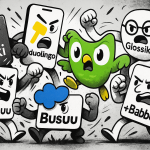Best Language Learning App with AI? See How Taalhammer Compares to Duolingo, Babbel, Busuu and LingQ [2025]
Just a few years ago, learning a language on your phone was mostly associated with quizzes, colorful flashcards, and monotonous word repetition. Today, that has changed dramatically. Thanks to the rapid development of educational technology, more and more people are searching for the best language learning app — one that not only shows vocabulary but helps you speak, understand, and think in a foreign language. Increasingly, users are turning to AI language learning apps — flexible, personalized, and far more effective than their predecessors.
It’s no longer just about how many words you memorize. It’s about how well you can use them in context. How deeply you understand what you’re saying. How quickly you can respond in a real conversation. And this is precisely where AI is changing the game.
In this article, we’ll take a closer look at how an AI-powered language learning app works, what features the most popular platforms offer (including Duolingo, Babbel, Busuu and LingQ), and how Taalhammer stands out — as a platform that not only uses AI, but harnesses its full potential to enable a more contextual, effective, and interactive language learning experience. We’ll also explore whether AI truly boosts learning outcomes and where the future of language education is heading.
- How Does an AI-Powered Language Learning App Actually Work?
- Taalhammer vs the Competition – Who Personalizes Language Learning Better?
- Creating Your Own Content – Only One App Gives You Full Control
- Exploring Vocabulary in Context — Which App Really Does It Right?
- AI Language Tools Compared — Who Really Gives You Control?
- Why Choose a Language Learning Platform Built Around AI?
- FAQ
- What is the best app to learn a language with AI?
- How does Taalhammer personalize language learning?
- Can AI language apps help me speak fluently?
- Does Duolingo use AI?
- What makes Taalhammer different from Babbel or Busuu?
- Can I use my own content in a language app?
- Is Taalhammer better for beginners or advanced learners?
- Does Taalhammer help with vocabulary retention?
How Does an AI-Powered Language Learning App Actually Work?
In the context of language learning, artificial intelligence means more than just automation. It refers to a system’s ability to learn from user data and adjust content in real time. Unlike traditional algorithms that follow fixed rules, an AI language learning app analyzes your progress, identifies weak areas, and generates personalized practice.
It’s a dynamic process — your learning path evolves as you do. Whether you’re improving vocabulary, working on grammar, or trying to speak fluently, a well-designed AI app for language learning adapts its content to your unique needs, helping you get better results faster.
In What Areas Do Language Learning Apps Use AI? Taalhammer vs Duolingo, Babbel, Busuu and LingQ
Different platforms use AI in different ways, often depending on their business model and technological maturity. Here are some notable examples of how major language learning apps with AI implement these features:
- Duolingo: Introduced GPT-4–based features like “Explain My Answer” and “Roleplay,” offering users interactive scenarios and AI-generated explanations. However, these are only available with the premium Duolingo Max plan. Learn more on Duolingo Max
- Babbel: Uses AI for speech recognition, allowing learners to practice pronunciation and receive instant feedback. AI also supports their “Daily Conversations” feature to simulate real-life speech.
- Busuu: Offers an AI Conversations function that simulates speaking exercises using natural dialog. The system gives personalized feedback, although customization is limited.
- LingQ: Relies on AI tools for simplifying imported content and creating interactive lessons. Users can bring in real-life articles, videos, or podcasts, and LingQ helps convert them into learning material. Explore LingQ
Taalhammer isn’t just a language app that uses AI — it’s a platform built around it. While most language tools treat artificial intelligence as a plugin or optional layer, Taalhammer uses AI as the foundation of the entire learning experience.
Instead of forcing learners through premade courses, Taalhammer allows you to create your own content, which the AI then expands, translates, organizes, and integrates into a personalized study plan.
Here’s how it works in practice:
- You create flashcards, phrases, or sentences — AI helps you complete and transform them into native-like expressions.
- You enter a word or sentence — the system suggests related phrases, contextual usage, and natural examples ready to learn instantly.
- You upload YouTube videos, Google Slides, or CSV files — AI transforms them into learning material that fits your goals and learning preferences.
- You define your goals — Taalhammer adapts content dynamically over time based on what you interact with, your performance, and what you’ve forgotten.
This isn’t just another AI-powered exercise. It’s a deeply contextual, responsive, and exploratory environment that grows with your progress. Every feature in Taalhammer — from the smart search engine to thematic collections — is designed to let you control the what, how, and when of learning.
What Does AI Actually Offer Language Learners — and Does It Work?
The integration of artificial intelligence in language learning apps has fundamentally changed how we approach language acquisition. Instead of rigid courses and identical content for all users, AI-powered tools can now create a flexible, personalized learning environment that adapts in real time to the needs, mistakes, and progress of each individual.
When well-designed, an AI-based language learning app can:
- Personalize content dynamically: It doesn’t just evaluate your right or wrong answers — it monitors how fast you learn, what kinds of errors you repeat, and what types of content you’re most engaged with. As a result, every learning session becomes more targeted and efficient.
- Increase engagement through interactivity: Whether it’s simulated dialogues, follow-up questions, or instant grammar hints, AI makes your learning more active and responsive — helping you understand the logic of a language, not just memorize isolated rules.
- Broaden your learning materials: Advanced language apps with AI like Taalhammer allow you to import your own content — notes, articles, emails, or presentation slides — and convert it into personalized flashcards and contextual exercises.
- Optimize your memory retention: With built-in spaced repetition algorithms tailored to your personal forgetting curve, the system tells you exactly when to review a phrase so you remember it long term.
Taalhammer, which uses AI technology as the core engine of its platform, excels in all of these areas. It lets you create your own learning material, provides intelligent suggestions, detects logic or grammar issues, and — when you click on any word — instantly shows you related structures and texts that reinforce what you’re learning.
So instead of memorizing a disconnected list of words, you gradually build a deeper intuition for the language. You learn to understand its structure, use it in real contexts, and truly think in a foreign language.
Taalhammer vs the Competition – Who Personalizes Language Learning Better?
How does personalization work in Duolingo, Babbel, Busuu, and LingQ vs Taalhammer?
Duolingo offers personalized learning modules that analyze the user’s progress and preferences to provide a more effective and engaging language learning experience. Thanks to AI-powered algorithms, this popular language learning app adjusts to the learner’s skill level, identifying strengths and weaknesses to improve retention and long-term results.
Babbel has introduced AI-supported features like Speech Recognition and Daily Conversations, which help users practice real-life dialogue and build speaking confidence. These tools make it easier to master key phrases and reduce the time needed to achieve conversational fluency — especially for users looking for a language app that helps improve pronunciation and fluency.
Busuu focuses on a personalized learning path tailored to each user’s level and learning goals. Its AI Conversations feature simulates realistic dialogues to support speaking practice in context. While Busuu uses artificial intelligence to track progress and suggest relevant content, it doesn’t support content creation — so the personalized learning it offers is more about sequencing and feedback than full control over what you learn.
LingQ builds its personalization around content imported by the user. It allows learners to study from authentic materials — including articles, podcasts, transcripts, and books — which users upload themselves. Although it doesn’t use advanced AI to analyze a learner’s style or recommend content dynamically, LingQ gives significant control over how and what you read or listen to. This model appeals especially to independent learners and more advanced users who want to learn a language through immersion in real-world content.
What Data Does Taalhammer Analyze to Personalize Language Learning?
Taalhammer stands out among AI-powered language learning tools by offering deep personalization. Unlike many other apps, it doesn’t only evaluate whether your answer is right or wrong. It also tracks your learning speed, content preferences, and individual learning goals. This level of insight allows the app to adapt its content precisely to your needs — making your study time more efficient and focused.
The system analyzes, among others:
- Learning speed – How fast you memorize new phrases, how often you return to certain topics, and how much time you need to successfully review a sentence or word.
- Common errors and difficulties – The AI identifies the grammatical structures that cause you the most trouble and then suggests similar examples in varying contexts to reinforce your understanding.
- Topic preferences – Based on the words you click on, phrases you choose, and flashcards you create, Taalhammer builds a profile of your interests and recommends sentences and texts with similar content.
- Content interaction history – The app keeps track of which sentences you repeat, edit, delete, or explore further. It also monitors how often you use the AI-powered search tool, the content creator, or import your own materials.
- Learning goals and target language – If you set a specific goal (e.g. preparing for work-related conversations or travel), Taalhammer selects relevant vocabulary and phrases to match that context.
In practice, this means every learner gets a slightly different experience — not just because they’re learning different languages, but because their learning path is uniquely built day by day, based on their habits and choices. Taalhammer doesn’t follow a one-size-fits-all course. Instead, it uses adaptive learning technology and artificial intelligence in language learning to build a path that’s responsive to the learner’s development.
That’s exactly why Taalhammer can be called a truly personalized language learning app powered by AI — not just a review tool or quiz generator.
Why Do “One-Size-Fits-All” Language Courses No Longer Work?
Traditional, universal language courses often fail to consider individual learning styles and needs. This lack of personalization can quickly lead to frustration, lack of motivation, and slower progress.
In contrast, AI-powered language learning apps like Taalhammer, Duolingo, and Babbel provide customized learning experiences that adapt to the user’s pace, interests, and learning goals. These adaptive learning tools track your performance, respond to your strengths and weaknesses, and deliver content that actually matches your personal context.
Thanks to this approach, learning becomes more engaging and, most importantly, more effective.
Creating Your Own Content – Only One App Gives You Full Control
Many language learning apps provide pre-made sets of flashcards and structured courses that users can browse and learn from. However, the ability to create your own materials is often limited or clunky.
Most popular language learning apps rely on fixed content. While useful for beginners, they rarely allow users to build or customize their own materials.
What Does Taalhammer let you do compared with Duolingo, Busuu, Babbel and LingQ ?
- Duolingo only offers structured exercises. Users cannot add custom sentences or vocabulary — the system doesn’t support user-generated content.
- Babbel uses structured lessons but doesn’t allow users to edit or expand them. All materials are locked inside fixed course modules.
- Busuu also doesn’t support a content creation feature. Users can write messages to the community, but they cannot build their own learning sets.
- LingQ allows you to import external texts, such as articles or transcripts, but it doesn’t process them automatically. There’s no system to convert imported content into learnable, interactive material. Check this article to see other the ways LingQ uses AI.
Taalhammer stands out by giving users full control over the creation and personalization of content. With this app, you can:
- Create your own flashcards, phrases, and sentence sets;
- Add multimedia materials like YouTube videos or Google Slides presentations;
- Use the built-in AI translator to generate natural language examples automatically;
- Organize content into collections and topic boards tailored to your needs.
Thanks to these features, Taalhammer offers a unique, user-driven language learning experience — ideal for learners who want to work with content that reflects their interests, goals, or daily communication needs.
How Does the AI Creator in Taalhammer Work?
The AI Creator in Taalhammer is a tool that allows users to generate personalized language learning content tailored to their goals and interests. Here’s how it works:
- Content creation: The user types in a sentence or phrase they want to learn — this can be anything from casual expressions to technical jargon.
- AI analysis: The built-in AI analyzes the input, identifying key words, grammar patterns, and overall structure.
- Example generation: Based on this analysis, the AI generates additional example sentences and relevant contexts in which the original phrase might naturally appear.
- Personalization: Users can then fine-tune the generated content — adding notes, translations, or even multimedia like YouTube videos or Google Slides.
This process ensures that learning is not just tailored — it’s deeply contextualized. By working with content that matters to them, learners build connections that are easier to remember and more meaningful in real-life communication.
Taalhammer
| Feature | Description |
|---|---|
| AI-generated content | Yes – the AI generates sentences, translations, and expands context. |
| Custom flashcards | Yes – users can create flashcards, sentences, and collections. |
| AI expands user input | Yes – the AI analyzes and develops user-entered content. |
Duolingo
| Feature | Description |
|---|---|
| AI-generated content | Yes, but only in premium features (Duolingo Max). |
| Custom flashcards | No. |
| AI expands user input | No – all content is system-generated. |
Babbel
| Feature | Description |
|---|---|
| AI-generated content | Partially – AI assists with dialogues and pronunciation. |
| Custom flashcards | No. |
| AI expands user input | No – content cannot be edited or developed by AI. |
Busuu
| Feature | Description |
|---|---|
| AI-generated content | Yes – the AI creates conversational practice exercises. |
| Custom flashcards | No. |
| AI expands user input | No – user entries are not enhanced by AI. |
LingQ
| Feature | Description |
|---|---|
| AI-generated content | No – does not use AI to generate content. |
| Custom flashcards | Yes – users can import their own texts. |
| AI expands user input | No – the system does not enhance content with AI. |
If you’re looking for a language learning app with AI-generated flashcards and examples, Taalhammer gives you the tools to turn any sentence into a full-fledged language lesson.
Why Custom Content Teaches Better Than Pre-Made Courses
Creating your own language learning materials brings significant advantages over following generic, one-size-fits-all lessons. Here’s why:
- Deeper understanding: When you create your own sentences, you’re forced to think through grammar structures and word choices. This active process leads to much more effective language acquisition.
- Higher engagement: Working with content based on your own interests and context increases motivation. You’re not just memorizing — you’re building meaningful connections.
- Better memory retention: Custom content is more emotionally relevant and easier to remember. What matters to you stays with you longer.
Unlike ready-made courses, which often feel too broad or disconnected, a personalized language learning experience allows you to focus on the vocabulary, grammar, and real-life contexts that are most useful to you.
Want to explore how different apps handle user-created content? Check out this article where I compared 12 language learning apps with a focus on customization and user control.
Exploring Vocabulary in Context — Which App Really Does It Right?
Learning new words in isolation often leads to difficulties when trying to use them in real conversations. Understanding how a word behaves in different sentences, situations, and grammatical structures is essential for achieving language fluency. That’s why contextual vocabulary learning is such a critical aspect of modern education.
How Do Taalhammer Duolingo, Babbel, Busuu and LingQ Support Context-Based Learning?
Understanding words in context is essential for real-world fluency, and not all apps approach this the same way. Let’s compare how each platform supports contextual language learning:
Taalhammer takes this challenge seriously. Its AI-powered language tool includes an advanced search engine that allows users to enter any word — either in their native language or the target language — and instantly find how that word is used in different contexts. The system searches through a vast database of millions of sentences, including content created by the user, and presents a wide range of usage examples. This makes it easier to grasp nuances, syntax, and meaning.
Duolingo:
Duolingo focuses primarily on short phrases and individual vocabulary items within a limited scope. While users can review a list of learned words, there is no advanced feature that allows for contextual word search. Learners are often left guessing how a word fits into broader usage.
Babbel:
Babbel provides themed lessons that present vocabulary in the context of daily situations. However, it lacks a tool for independently searching words in multiple contexts. Users follow structured content, which limits deeper exploration of how words function across different sentence structures.
Busuu:
Busuu teaches vocabulary through themed dialogues and topic-based exercises, giving users exposure to language in real-life situations. Still, the platform doesn’t offer a searchable database for words across varied sentence structures. There’s also no feature for tracking a single word’s usage across multiple contexts — restricting the depth of language exploration.
LingQ:
LingQ stands out with its use of authentic language materials — articles, podcasts, transcripts — ensuring words always appear in real context. Users can highlight, save, and revisit vocabulary across content. However, unlike Taalhammer, LingQ doesn’t offer a dedicated context search engine per word. Users rely heavily on the content they import, which makes the experience powerful for advanced learners, but less guided for others.
In traditional vocabulary learning, students often memorize isolated words without understanding how they function in real speech or writing. By contrast, AI-powered language learning apps like Taalhammer help users learn expressions, grammar patterns, and vocabulary directly within authentic, dynamic contexts — exactly as used in real-life communication.
AI Language Tools Compared — Who Really Gives You Control?
More and more language apps today include AI features. But many of them still limit user control by focusing on static quizzes or pre-designed courses. Only a few tools, like Taalhammer, are designed around personalization, interactivity, and content ownership.
What Does Taalhammer Do That Others Don’t?
Unlike its competitors, Taalhammer is not just a course — it’s a language learning platform powered entirely by artificial intelligence. What sets it apart?
- It teaches words and grammar structures in full context
- It lets users create and develop their own content
- It adapts learning materials based on user goals and learning style
- It provides tools to search and explore vocabulary through dynamic collections
- It reacts to user input in real time, adjusting the learning path as needed
Whether you’re studying vocabulary from your own notes, a YouTube video, or a presentation from work, Taalhammer can not only handle that — it will enhance it with AI-generated examples and suggestions that match your level and interests.
Where Does AI Make the Biggest Difference?
Based on the comparison of five leading language apps using AI, Taalhammer clearly stands out in areas where artificial intelligence isn’t just about automation — but about supporting real learning decisions:
Creating content based on your own data
| App | Capability |
|---|---|
| Taalhammer | Yes – AI analyzes and expands user-generated input. |
| Duolingo | No – only fixed gamified exercises. |
| Babbel | No – content is predefined by the curriculum. |
| Busuu | No – no content creation based on user data. |
| LingQ | Partial – users can import texts, but there’s no AI development. |
Exploring words in context
| App | Capability |
|---|---|
| Taalhammer | Yes – search shows full sentences and phrases in context. |
| Duolingo | Very limited – words appear in isolated sentences. |
| Babbel | Limited – context shown only in select dialogues. |
| Busuu | Limited – no searchable contextual vocabulary. |
| LingQ | Yes – words are highlighted in user-imported content. |
Personalized learning plan
| App | Capability |
|---|---|
| Taalhammer | Yes – adapts to your unique learning style and progress. |
| Duolingo | Partial – adapts pace based on activity only. |
| Babbel | Partial – follows a linear path with initial placement test. |
| Busuu | Yes – adaptive learning and smart review. |
| LingQ | Yes – user-driven, but no AI personalization. |
Learning from your own materials (texts, videos)
| App | Capability |
|---|---|
| Taalhammer | Yes – AI processes YouTube, Google Slides, and CSV files. |
| Duolingo | No – doesn’t support user-added content. |
| Babbel | No – only uses internal lessons. |
| Busuu | No – no feature for personal materials. |
| LingQ | Yes – users can import texts and audio, but not AI-enhanced. |
Generating natural language examples
| App | Capability |
|---|---|
| Taalhammer | Yes – AI generates contextual, natural-sounding sentences. |
| Duolingo | No – uses preset, often simplified examples. |
| Babbel | No – relies on static dialogues and translations. |
| Busuu | Partial – includes examples in dialogues, not dynamically generated. |
| LingQ | No – uses authentic content but doesn’t generate new examples. |
Why Choose a Language Learning Platform Built Around AI?
Taalhammer doesn’t treat artificial intelligence as a side feature — AI is the core engine of the entire system. Unlike traditional apps that offer static exercises or basic automation, Taalhammer uses AI to actively support your progress at every step of the journey.
If you’re looking for the best AI language learning app that allows you to create custom content, explore language in context, and truly adapt to your goals — Taalhammer is built for that.
FAQ
What is the best app to learn a language with AI?
While several apps use AI in some form, Taalhammer stands out for how deeply AI is integrated. Unlike apps like Duolingo or Babbel, which use AI for grammar feedback or pronunciation checks, Taalhammer allows you to generate your own content, personalize your lessons, and learn through real-world context — all powered by AI.
How does Taalhammer personalize language learning?
Taalhammer analyzes your learning pace, the kinds of mistakes you make, your preferred topics, and your long-term goals. Based on that, it creates custom flashcards, suggests context-rich sentences, and builds collections tailored to how you learn best. It’s one of the few language learning platforms that uses AI to truly adapt to the learner in real time.
Can AI language apps help me speak fluently?
Yes — especially those that focus on context-based learning and content creation, like Taalhammer. While apps like Busuu or Duolingo offer speaking simulations, Taalhammer lets you practice with your own sentences, helping you build fluency faster by focusing on phrases that matter to you.
Does Duolingo use AI?
Duolingo uses AI mainly in its premium version (Duolingo Max), for features like “Explain My Answer” and conversation roleplays. However, it doesn’t let users generate or personalize content using AI like Taalhammer does.
What makes Taalhammer different from Babbel or Busuu?
Babbel and Busuu follow a structured curriculum. Taalhammer flips that model — you create the content, and AI builds the course around you. This means you’re always learning relevant vocabulary, grammar, and sentence patterns, not just what’s in a preset lesson.
Can I use my own content in a language app?
Yes — but only a few apps support it. Taalhammer is the only one in this comparison that allows full integration of your own texts, YouTube videos, Google Slides, or even CSV files — and then transforms them into structured, personalized learning materials using AI.
Is Taalhammer better for beginners or advanced learners?
Both. Beginners benefit from curated starter collections, while advanced learners can import and build content around their own interests or professional needs. The AI adapts to your level dynamically.
Does Taalhammer help with vocabulary retention?
Yes, through spaced repetition powered by AI. Taalhammer tracks how well you remember words and phrases and schedules smart review sessions based on your personal forgetting curve.








